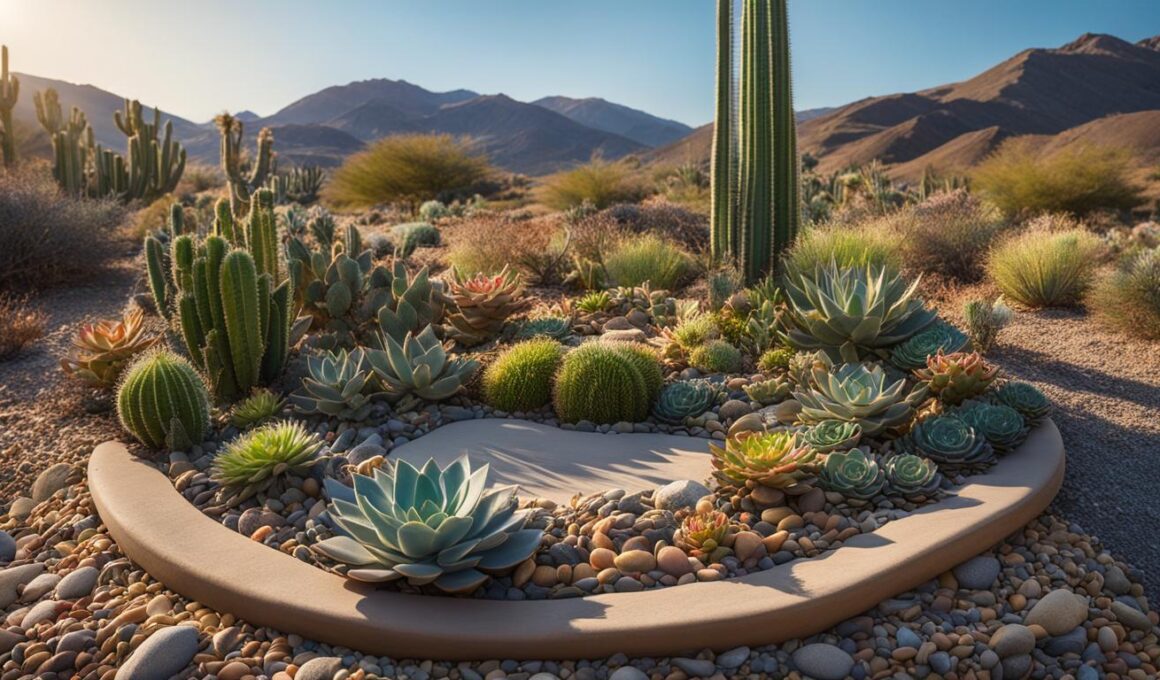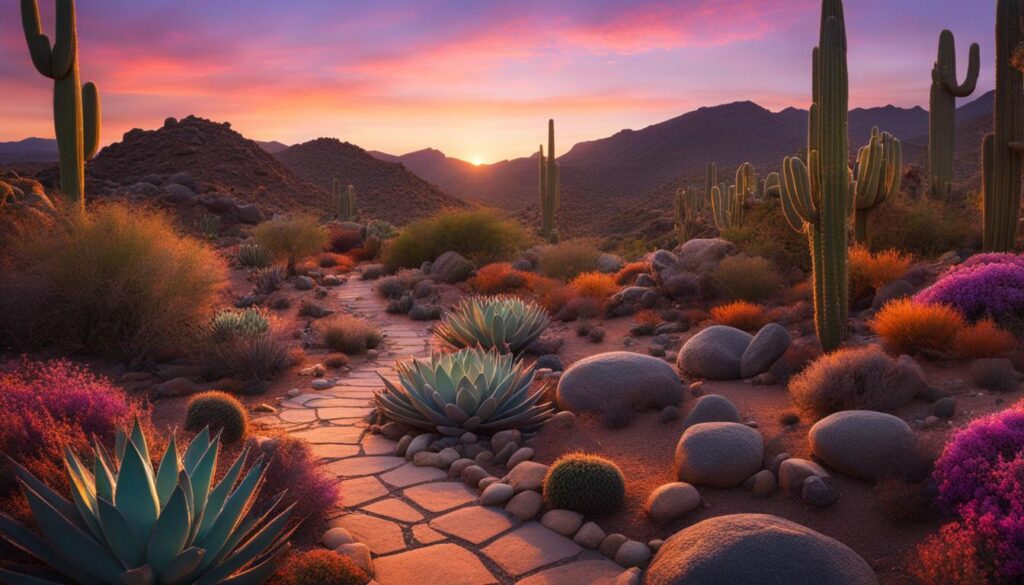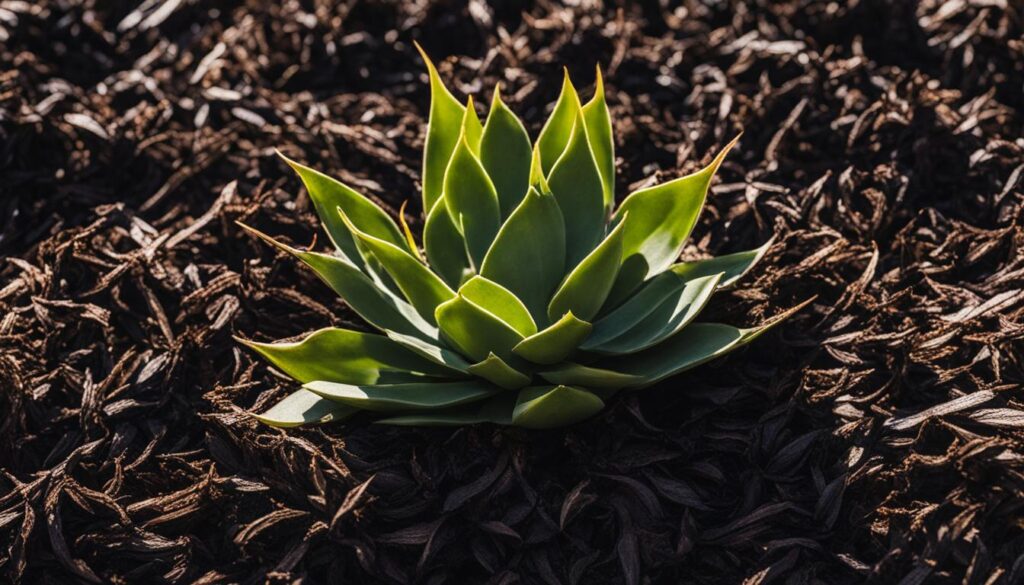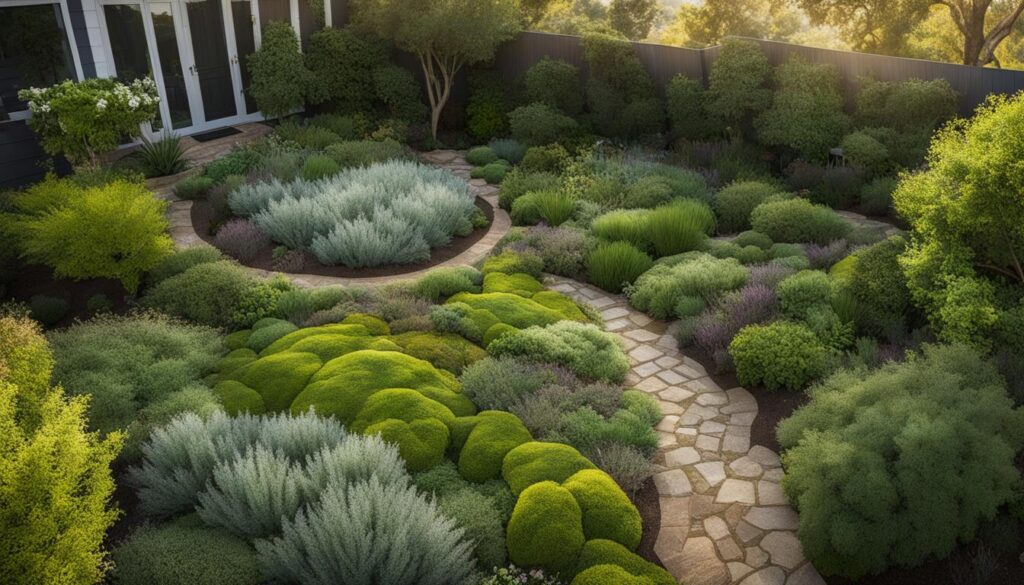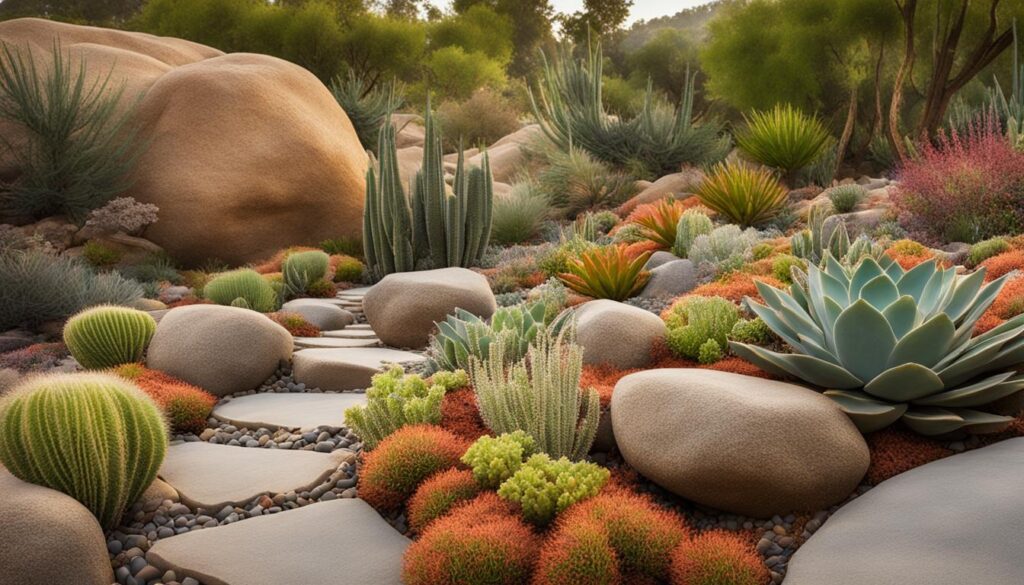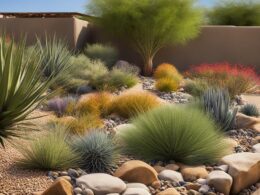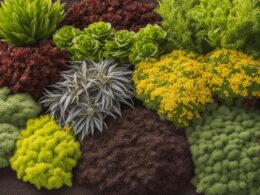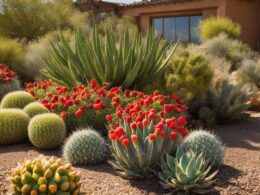Welcome to our comprehensive guide to easy and low-maintenance xeriscape ideas for beginners. If you live in a dry environment and want a beautiful yard without the hassle of extensive maintenance, xeriscaping is the perfect solution for you. In this guide, we will explore the benefits of xeriscaping, popular landscaping designs, the use of mulch and rocks, the selection of native plants, the importance of drip irrigation, the incorporation of seating areas, the use of ground cover plants and ornamental grasses, and how to create a rain garden and collect rainwater.
Key Takeaways:
- Xeriscaping allows homeowners to create low-maintenance and eco-friendly landscapes in dry environments.
- By implementing xeriscape ideas, beginners can create stunning yards without the need for extensive maintenance.
- Xeriscaping offers benefits such as water conservation, increased property value, and the elimination of the need for mowing and fertilizers.
- Popular xeriscape designs include exotic desert landscapes and cottage-style blends of grasses and wildflowers.
- Mulch plays a significant role in xeriscaping by improving soil fertility, limiting weed growth, and adding curb appeal.
The Benefits of Xeriscaping
Xeriscaping offers numerous benefits, making it an ideal choice for homeowners looking to create low-maintenance and water-efficient landscapes. By implementing xeriscape ideas, you can contribute to water conservation efforts while still enjoying a beautiful yard.
Water Conservation: One of the key benefits of xeriscaping is its ability to conserve water. Xeriscape designs focus on using drought-tolerant plants that require less irrigation. By reducing water usage in your landscaping, you can help preserve this valuable resource and save on your water bills.
Low-Maintenance Landscapes: Xeriscape designs are known for their low-maintenance nature. By selecting plants that are well-suited to your local climate and soil conditions, you can minimize the need for regular watering, mowing, and fertilizing. This allows you to spend less time and effort on yard maintenance, freeing you up to enjoy your outdoor space.
Environmental Sustainability: Implementing xeriscape ideas in your yard promotes environmental sustainability. By reducing water usage, xeriscaping helps protect natural water sources and supports a more eco-friendly approach to landscaping. Additionally, xeriscape designs often incorporate native plants, which provide essential habitats for local wildlife.
Table: Comparison of Xeriscaping Benefits
| Benefit | Description |
|---|---|
| Water Conservation | Xeriscaping reduces water usage through the use of drought-tolerant plants and efficient irrigation methods. |
| Low-Maintenance | Xeriscape designs require less time and effort for maintenance tasks such as watering, mowing, and fertilizing. |
| Environmental Sustainability | By minimizing water consumption and selecting native plants, xeriscaping promotes a more sustainable approach to landscaping. |
By considering the benefits of xeriscaping, you can make informed decisions about your landscaping choices. With water conservation, low-maintenance landscapes, and environmental sustainability at the forefront, xeriscape ideas offer a practical and visually appealing solution for your yard.
Popular Xeriscape Landscaping Designs
Xeriscape designs offer a wide range of possibilities, allowing homeowners to create unique and beautiful landscapes that require minimal water and maintenance. Whether you prefer a desert-inspired look or a more traditional cottage-style garden, there are various popular xeriscape designs to choose from. Exploring these landscape design ideas will help you find inspiration and select the style that best suits your preferences and environment.
Desert Landscapes
Desert landscapes are a popular choice for xeriscape designs in dry and arid regions. These designs often incorporate cacti, succulents, and rocks to mimic the natural beauty of the desert. The use of gravel or sand as ground cover helps to retain moisture and reduces evaporation. Desert landscapes can create a stunning and low-maintenance garden that thrives in hot and dry conditions.
Mediterranean Gardens
Mediterranean-style gardens are another popular option for xeriscape designs. These gardens typically feature drought-tolerant plants, such as lavender, rosemary, and olive trees, that are commonly found in the Mediterranean region. With their aromatic scents and vibrant colors, these plants add beauty and a touch of elegance to the landscape. Mediterranean gardens often incorporate pathways and seating areas to create a relaxing and inviting outdoor space.
Wildflower Meadows
Wildflower meadows are a favorite choice for those who prefer a more natural and vibrant look. These designs consist of native wildflowers, such as coneflowers, black-eyed Susans, and California poppies, that attract pollinators like bees and butterflies. Incorporating native grasses and perennials can add texture and height to the meadow, creating a visually appealing landscape. Wildflower meadows are not only beautiful but also help support local ecosystems and biodiversity.
| Xeriscape Design | Description |
|---|---|
| Desert Landscapes | Inspired by arid regions, these designs feature cacti, succulents, and rocks to create a desert-like atmosphere. |
| Mediterranean Gardens | Showcasing drought-tolerant plants, such as lavender and rosemary, these gardens evoke the beauty of the Mediterranean. |
| Wildflower Meadows | Full of native wildflowers, these meadows provide a colorful and natural look while supporting local ecosystems. |
Choosing a xeriscape design that aligns with your personal style and regional climate is key to creating a successful and visually stunning landscape. Whether you opt for a desert-inspired theme, a Mediterranean ambiance, or a vibrant wildflower meadow, implementing xeriscape principles will help you conserve water, reduce maintenance, and create an eco-friendly outdoor space.
The Importance of Mulch in Xeriscaping
Xeriscaping is a water-wise landscaping technique that promotes sustainable gardening in dry climates. One key element of successful xeriscaping is the use of mulch. Mulch plays a crucial role in conserving water, improving soil fertility, limiting weed growth, and enhancing the overall appearance of the landscape.
Mulch acts as a protective layer on the soil surface, reducing evaporation and helping to retain moisture. This is especially important in xeriscaping, where water conservation is a priority. By reducing water loss through evaporation, mulch helps plants to thrive even in arid conditions.
Furthermore, mulch enriches the soil as it breaks down over time. It adds organic matter, nutrients, and beneficial microorganisms, improving the fertility and structure of the soil. This creates a healthy environment for plants, allowing them to establish strong root systems and withstand drought stress.
Xeriscape Mulch Types
When choosing mulch for xeriscaping, it’s important to consider the specific needs of your landscape. There are various types of mulch available, each with its own benefits and aesthetic appeal.
| Mulch Type | Benefits |
|---|---|
| Organic Mulch | Breaks down gradually, adds nutrients to the soil, improves soil structure, and increases earthworm activity. |
| Inorganic Mulch | Durable, long-lasting, and effective at weed suppression. Options include gravel, pebbles, and landscape fabric. |
| Rock Mulch | Provides insulation, prevents erosion, and adds a decorative element to the landscape. Suitable for desert-inspired xeriscapes. |
| Rubber Mulch | Environmentally friendly option made from recycled tires. Retains moisture, suppresses weeds, and doesn’t attract pests. |
Choosing the right mulch type depends on factors such as climate, desired aesthetics, and maintenance preferences. Consider consulting with a local horticulture expert or xeriscaping professional to determine the best mulch option for your specific xeriscape design.
“Mulch acts as a protective layer on the soil surface, reducing evaporation and helping to retain moisture. This is especially important in xeriscaping, where water conservation is a priority.”
Drought-Tolerant Groundcovers: A Low-Maintenance Solution for Lawn Replacement
When it comes to xeriscaping, replacing your traditional grassy lawn with drought-tolerant groundcovers is an excellent way to create a low-maintenance and eco-friendly landscape. Drought-tolerant groundcovers not only require less water but also provide a variety of textures, colors, and forms that can enhance the visual appeal of your yard. These low-maintenance grasses are perfect for beginners looking to minimize water usage and reduce the need for constant mowing and upkeep.
One popular option for drought-tolerant groundcovers is creeping thyme. This hardy perennial plant forms a dense mat of small, aromatic leaves and produces tiny pink or purple flowers in the spring and summer. Creeping thyme spreads quickly, effectively covering large areas of ground and suppressing weeds. Another great choice is lantana, a colorful plant known for its ability to thrive in dry conditions. Lantana comes in a variety of vibrant hues, attracting butterflies and hummingbirds to your garden.
To add visual interest and create a diverse xeriscape, consider incorporating silver carpet or zoysiagrass. Silver carpet, also known as Dymondia, is a low-growing groundcover with silvery-gray leaves that create a beautiful contrast in your landscape. Zoysiagrass, on the other hand, is a dense, slow-growing grass that requires less mowing and watering than traditional lawn grasses. By mixing different species of drought-tolerant groundcovers, you can achieve a stunning and low-maintenance xeriscape design.
Table: Comparison of Drought-Tolerant Groundcovers
| Groundcover | Water Needs | Growth Habit | Key Features |
|---|---|---|---|
| Creeping Thyme | Low | Spreading | Aromatic leaves, pink/purple flowers |
| Lantana | Low | Spreading | Colorful flowers, attracts butterflies |
| Silver Carpet (Dymondia) | Low | Mat-forming | Silvery-gray leaves, drought-tolerant |
| Zoysiagrass | Low | Dense | Slow-growing, requires less mowing |
By replacing your lawn with drought-tolerant groundcovers, you can significantly reduce your water consumption and spend less time maintaining your yard. These low-maintenance grasses not only add beauty to your landscape but also contribute to a more sustainable and eco-friendly environment. So, why not embrace xeriscaping and create a stunning, low-maintenance garden that will thrive even in dry conditions?
Incorporating Garden Paths in Xeriscape Designs
Garden paths play a crucial role in enhancing the beauty and functionality of xeriscape designs. They not only provide a walkway for you and your guests to navigate through your landscape but also create visual interest and guide the eye towards specific focal points. Additionally, when designed with careful consideration, garden paths can be used to collect rainwater and promote its absorption into the soil, contributing to the overall sustainability of your xeriscape.
When incorporating garden paths into your xeriscape design, consider using permeable materials such as gravel, spaced pavers, or stepping stones. These materials allow rainwater to penetrate the ground, reducing runoff and maximizing water retention in the soil. Overlying pavers on crushed stone further enhances permeability, allowing rainwater to reach the roots of plants more effectively.
Captivating Garden Path Ideas:
- Curved paths: Create a sense of intrigue and fluidity by designing curved garden paths that meander through your xeriscape. This design not only adds visual interest but also encourages a leisurely stroll.
- Colorful stepping stones: Incorporate vibrant and decorative stepping stones into your garden path to add a pop of color and individuality to your xeriscape. Choose stones that complement the overall aesthetic and theme of your landscape.
- Plant-lined walkways: Frame your garden path with lush and drought-tolerant plants to create a natural and inviting atmosphere. Select low-growing ground covers or ornamental grasses that thrive in your local climate.
- Integrate seating areas: Along your garden path, consider incorporating seating areas that invite relaxation and contemplation. These areas can be adorned with comfortable benches, cozy chairs, or even a hammock, allowing you to fully enjoy the tranquility of your xeriscape.
By thoughtfully designing your garden paths, you can not only enhance the functionality of your xeriscape but also contribute to rainwater collection and sustainable landscaping practices. Embrace creativity and incorporate the elements that resonate with your style to create a harmonious and visually captivating xeriscape design.
| Garden Path Materials | Permeability | Benefits |
|---|---|---|
| Gravel | High | Excellent water drainage and soil moisture retention. |
| Spaced pavers | High | Rainwater infiltration while providing a stable and level surface. |
| Stepping stones | Medium | Adds aesthetic appeal and allows some water absorption. |
Designing garden paths is an opportunity to showcase your creativity and add a touch of uniqueness to your xeriscape. The curved paths, colorful stepping stones, and plant-lined walkways not only contribute to the visual appeal but also help with rainwater collection. So, take the time to plan and create garden paths that not only serve their purpose but also enhance the overall beauty of your xeriscape design.
Creating Low-Maintenance Rock Gardens
A rock garden is a perfect addition to a low-maintenance xeriscape design. Rock gardens not only add visual interest to your yard but also require minimal upkeep. By incorporating drought-resistant plants and utilizing rocks strategically, you can create a stunning and hassle-free landscape.
Benefits of Rock Gardens
Rock gardens offer several benefits for low-maintenance landscaping. Firstly, the rocks help retain moisture in the soil, reducing the need for frequent watering. This is especially beneficial in dry climates where water conservation is essential. Additionally, the combination of rocks and plants creates a natural and harmonious aesthetic that can withstand various weather conditions.
“Rock gardens not only add visual interest to your yard but also require minimal upkeep.”
Choosing the Right Plants
When selecting plants for your rock garden, opt for those that are drought-resistant and low-maintenance. Succulents and cacti are excellent choices as they store water in their leaves and stems, requiring minimal watering. Other suitable options include lavender, yarrow, sedum, and thyme. These plants are not only hardy but also add color and texture to your rock garden.
Design Tips
When designing your rock garden, consider the placement and size of the rocks. Arrange them in a way that mimics the natural look of a rocky landscape. Vary the size and shape of the rocks to create texture and depth. Additionally, use larger rocks as focal points and surround them with smaller plants to create a visually appealing composition.
| Plant | Watering Needs | Height | Sun Exposure |
|---|---|---|---|
| Succulents | Low | Varies | Full sun |
| Cacti | Low | Varies | Full sun |
| Lavender | Low | 1-3 feet | Full sun |
| Yarrow | Low | 1-3 feet | Full sun |
| Sedum | Low | Varies | Full sun |
| Thyme | Low | Varies | Full sun |
Incorporating Mediterranean Herbs in Xeriscape Gardens
Incorporating Mediterranean herbs in your xeriscape garden is a great way to add beauty, fragrance, and functionality to your landscape. These drought-hardy plants thrive in full sun and well-drained soils, making them perfect for water-wise gardening. Not only do they require less water, but they also provide culinary delights and attract beneficial pollinators to your garden.
The Benefits of Mediterranean Herbs
Mediterranean herbs, such as thyme, rosemary, oregano, and lavender, offer several benefits when incorporated into your xeriscape garden. These herbs not only add visual interest with their varying heights, textures, and colors but also release fragrances that have calming effects. In addition, their aromatic oils can help repel pests, making them excellent natural companions for your other plants.
By planting lavender along your garden paths, you can create a sensory experience as the gentle scent wafts through the air during your walks. This not only enhances the overall ambiance of your xeriscape garden but also provides a soothing and relaxing environment for you to enjoy.
Choosing the Right Mediterranean Herbs
When selecting Mediterranean herbs for your xeriscape garden, consider the specific growing conditions in your area. Thyme is a low-growing herb that forms beautiful ground covers and can be used between pavers or in rock gardens. Rosemary, with its upright growth habit and fragrant foliage, makes an excellent focal point in your garden. Oregano adds a pop of color with its small flowers, and its leaves can be used in various culinary dishes.
Lavender, perhaps the most iconic Mediterranean herb, not only provides stunning purple blooms but also attracts bees and butterflies to your garden. Its flowers can be harvested for use in crafts, culinary creations, or as dried fragrant bundles.
| Herb | Height | Growing Conditions | Uses |
|---|---|---|---|
| Thyme | Low-growing | Sunny, well-drained soil | Culinary herb, ground cover |
| Rosemary | Upright | Sunny, well-drained soil | Culinary herb, focal point |
| Oregano | Low-growing | Sunny, well-drained soil | Culinary herb, ground cover |
| Lavender | Varies by variety | Sunny, well-drained soil | Aromatic herb, pollinator attractor |
When planting Mediterranean herbs, ensure they receive adequate sunlight, well-drained soil, and proper spacing to allow for healthy growth. By incorporating these herbs into your xeriscape garden, you can enjoy their beauty, fragrance, and culinary benefits while conserving water and creating a sustainable and low-maintenance landscape.
Using Succulents in Xeriscape Containers
Succulents are a great choice for incorporating greenery into your xeriscape design using containers. These hardy plants are known for their ability to store water, making them drought-tolerant and low-maintenance. By utilizing succulents in your xeriscape containers, you can create visually appealing focal points while conserving water.
Benefits of Using Succulents in Xeriscape Containers
There are several benefits to using succulents in your xeriscape containers. First and foremost, their unique shapes, colors, and textures add visual interest and variety to your landscape. Succulents come in a wide range of shapes, from spiky to rounded, and colors, from vibrant greens to rich purples and blues. Their thick, fleshy leaves and stems create interesting textures that can be mixed and matched to create stunning combinations in your containers.
“Succulents are a great choice for adding color and texture to your xeriscape design, and they require little water and maintenance.”
Another benefit of using succulents is their ability to thrive in containers. Due to their water-storing capabilities, succulents can withstand periods of drought and require less frequent watering compared to other plants. This makes them an ideal choice for busy individuals or those who want to minimize their water usage without sacrificing the beauty of their landscapes.
Popular Succulents for Xeriscape Containers
When selecting succulents for your xeriscape containers, there are many options to choose from. Some popular choices include:
- Sedum: These low-growing succulents come in a variety of colors and are known for their attractive foliage.
- Aloe: Aloe vera and other aloe species are not only beautiful but also have medicinal properties.
- Echeveria: These rosette-shaped succulents come in a range of sizes and colors, making them versatile for container arrangements.
- Haworthia: These small succulents have distinctive leaf patterns and are ideal for smaller containers or rock gardens.
By selecting a variety of succulents with different growth habits and colors, you can create visually striking container arrangements that will thrive in your xeriscape design.
Choosing the Right Containers for Succulents
When choosing containers for your succulents, it’s important to consider their specific needs. Succulents prefer well-draining soil, so containers with drainage holes are essential. Terra cotta pots are a popular choice as they allow for better airflow and can help prevent overwatering and root rot. Additionally, consider the size of the containers, as some succulents prefer smaller spaces while others need room to spread and grow.
In conclusion, incorporating succulents in your xeriscape design using containers is a practical and visually appealing choice. By choosing the right succulents and containers, you can create stunning displays that require minimal maintenance and conserve water.
Conclusion
Xeriscaping is an excellent choice for creating a low-maintenance and environmentally friendly landscape. By implementing the easy and low-maintenance xeriscape ideas mentioned in this guide, you can enjoy a beautiful yard while conserving water and reducing the need for extensive maintenance.
With the use of mulch and rocks, you can improve soil fertility, limit weed growth, and enhance the overall aesthetic of your xeriscape. Selecting native plants and incorporating seating areas will not only attract wildlife but also increase your property value. Creating rain gardens and collecting rainwater will further contribute to water conservation and sustainability.
By adopting these xeriscape practices, you can create a stunning, eco-friendly yard that requires minimal effort to maintain. Embrace the benefits of low-maintenance xeriscape, explore different designs, and enjoy the beauty of an environmentally friendly landscape.
FAQ
What is xeriscaping?
Xeriscaping is a water-wise landscaping concept that allows homeowners to create beautiful and low-maintenance landscapes in dry environments.
What are the benefits of xeriscaping?
Xeriscaping offers numerous benefits including water conservation, low-maintenance landscapes, the creation of natural habitats for wildlife, increased property value, and the elimination of the need for mowing, herbicides, and fertilizers.
What are some popular xeriscape landscaping designs?
Some popular landscaping designs include exotic desert landscapes with cacti and rocks, as well as cottage-style blends of grasses and colorful wildflowers.
How does mulch play a role in xeriscaping?
Mulch helps to slow down evaporation, improve soil fertility and structure, limit weed growth, and add curb appeal to the landscape design.
How can I replace my traditional lawn with drought-tolerant groundcovers?
By choosing low-growing groundcover varieties such as creeping thyme, lantana, silver carpet, and zoysiagrass, you can replace your lawn with low-maintenance options that require less water and trimming.
How can I incorporate garden paths into my xeriscape design?
By choosing pavers with space between them and overlying them on crushed stone, you can collect and store rainwater in the soil as it flows through the garden.
How can I create a low-maintenance rock garden?
Boulders and rocks can be used in rock gardens to prevent evaporation and help trap moisture in the soil. Planting drought-resistant plants and ground covers around them adds color and texture to the landscape.
What Mediterranean herbs are suitable for xeriscape gardens?
Herbs such as thyme, rosemary, oregano, and lavender are ideal for xeriscape gardens as they thrive in full sun and well-drained soils, can be used for culinary purposes, and release fragrances that attract beneficial insects while repelling pests.
Can I use succulents in xeriscape designs?
Yes, succulents are a great choice for adding plants to xeriscape designs in containers. Their ability to store water makes them low-maintenance, and options such as cacti, agave, aloe, sedum, and gasteria add volume and structure to the landscape.
What are the key points to remember about xeriscaping?
Xeriscaping is an excellent option for creating low-maintenance and environmentally friendly landscapes. By implementing xeriscape ideas, beginners can reduce water usage, create natural habitats for wildlife, increase property value, and enjoy a beautiful yard without the need for extensive maintenance.





